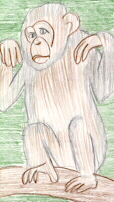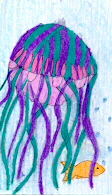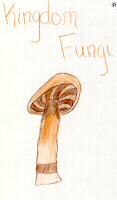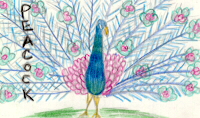Biology Postcards
 The chimpanzee lives in a troop that numbers between 25-80 chimps. Active by day, the chimpanzee sleeps at night in a tree, well above ground. Chimps stay mainly in trees during the rainy seasons and on the ground during the dry seasons. The chimps eat fruits of all kind and also honey and insects.
The chimpanzee lives in a troop that numbers between 25-80 chimps. Active by day, the chimpanzee sleeps at night in a tree, well above ground. Chimps stay mainly in trees during the rainy seasons and on the ground during the dry seasons. The chimps eat fruits of all kind and also honey and insects.
by Catie
More information about chimpanzees and other primates can be found at Primate Info Net
 A jellyfish kind of looks like an umbrella. The long strands of legs called "tentacles" can sting and seriously harm its prey. Some fish can hide from other fish in the tentacles of a jellyfish and not be harmed by its sting.
A jellyfish kind of looks like an umbrella. The long strands of legs called "tentacles" can sting and seriously harm its prey. Some fish can hide from other fish in the tentacles of a jellyfish and not be harmed by its sting.
by Kimberly
More information about jellyfish and other cnidarians can be found at Phylum Cnidaria
 The kingdom Fungi includes the yeasts, molds, mushrooms, and mildews, as well as many parasitic forms. Although yeasts are unicellular, most other fungi consist of numerous long multicellular filaments. Their cells are eukaryotic. Because of their thick cell walls, fungi were once regarded as non-photosynthetic plants.
The kingdom Fungi includes the yeasts, molds, mushrooms, and mildews, as well as many parasitic forms. Although yeasts are unicellular, most other fungi consist of numerous long multicellular filaments. Their cells are eukaryotic. Because of their thick cell walls, fungi were once regarded as non-photosynthetic plants.
by Laura
More information about fungi can be found at MykoWeb
 The peacock is the male blue peafowl. This colorful ornamental bird can now be seen all over the world. It is mostly known for the cock's bright train of feathers. Peacocks always live near a water source to drink at dawn and dusk.
The peacock is the male blue peafowl. This colorful ornamental bird can now be seen all over the world. It is mostly known for the cock's bright train of feathers. Peacocks always live near a water source to drink at dawn and dusk.
by Megan
More information about birds can be found at Peterson Online
Click here for Page 1
Click here for Page 3
Click here for Mrs. N. Spires' Biology Page
This page hosted by  Get your own Free Home Page
Get your own Free Home Page
 The chimpanzee lives in a troop that numbers between 25-80 chimps. Active by day, the chimpanzee sleeps at night in a tree, well above ground. Chimps stay mainly in trees during the rainy seasons and on the ground during the dry seasons. The chimps eat fruits of all kind and also honey and insects.
The chimpanzee lives in a troop that numbers between 25-80 chimps. Active by day, the chimpanzee sleeps at night in a tree, well above ground. Chimps stay mainly in trees during the rainy seasons and on the ground during the dry seasons. The chimps eat fruits of all kind and also honey and insects. A jellyfish kind of looks like an umbrella. The long strands of legs called "tentacles" can sting and seriously harm its prey. Some fish can hide from other fish in the tentacles of a jellyfish and not be harmed by its sting.
A jellyfish kind of looks like an umbrella. The long strands of legs called "tentacles" can sting and seriously harm its prey. Some fish can hide from other fish in the tentacles of a jellyfish and not be harmed by its sting. The kingdom Fungi includes the yeasts, molds, mushrooms, and mildews, as well as many parasitic forms. Although yeasts are unicellular, most other fungi consist of numerous long multicellular filaments. Their cells are eukaryotic. Because of their thick cell walls, fungi were once regarded as non-photosynthetic plants.
The kingdom Fungi includes the yeasts, molds, mushrooms, and mildews, as well as many parasitic forms. Although yeasts are unicellular, most other fungi consist of numerous long multicellular filaments. Their cells are eukaryotic. Because of their thick cell walls, fungi were once regarded as non-photosynthetic plants. The peacock is the male blue peafowl. This colorful ornamental bird can now be seen all over the world. It is mostly known for the cock's bright train of feathers. Peacocks always live near a water source to drink at dawn and dusk.
The peacock is the male blue peafowl. This colorful ornamental bird can now be seen all over the world. It is mostly known for the cock's bright train of feathers. Peacocks always live near a water source to drink at dawn and dusk.